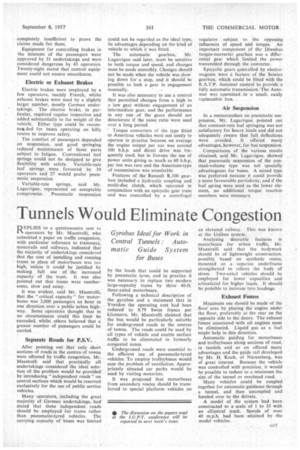Tunnels Would Eliminate Congestion
Page 61

If you've noticed an error in this article please click here to report it so we can fix it.
REPL1ES to a questionnaire sent to operators by Mr. Maestrelli, who submitted a paper on traffic congestion, with particular reference to tramways, monorails and railways, indicated that the majority of undertakings considered that the cost of installing and running trams in place of motorbuses was too high, unless it could be justified by making full use of the increased capacity of the tram. It was also pointed out that trams were cumbersome, slow and noisy.
It was evident, said Mr. Maestrelli, that the "critical capacity" for motorbuses was 2,000 passengers an hour in one direction over a public urban highway. Some operators thought that in no circumstances could this limit be -exceeded, whilst others believed that a greater number of passengers could be carried.
Separate Roads for P.S.V.
After pointing out that only shcirt sections of roads in the centres of towns were affected by traffic congestion, Mr. Maestrelli said that practically all undertakings considered the ideal solution of the problem would be provided by introducing "independent roads" on central sections which would be reserved exclusively for the use of public service vehicles.
Many operators, including the great majority of German undertakings, had stated that these independent roads should be employed for trams rather than pneumatic-tyred vehicles. The carrying capacity of buses was limited by the loads that could be supported by pneumatic tyres, and in. practice it was necessary to replace two modern large-capacity trams by three 40-ft. three-axled motorbuses.
Following a technical description of the gyrobus and a statement that in Yverdon the operating cost had been reduced to 0.79 Swiss francs per kilometre, Mr. Maestrelli claimed that the bus would be particularly suitable for underground roads in the centres of towns. The roads could be used by all types of vehicle and enable surface traffic to be eliminated in formerly congested zones.
Underground roads were essential to the efficient use of pneumatic-tyred vehicles. To employ trolleybuses would ease the problem of ventilation. Appropriately situated car parks would be used by visiting motorists.
It was proposed that motorbuses from secondary routes should be transferred to special platform vehicles on an elevated railway. This was known as the Unibus system.
Analysing desirable features in motorbuses for urban traffic, Mr. Maestrelli said that the bodywork should be of lightweight construction. possibly based on synthetic resins, mounted on a separate underframe strengthened to relieve the body of stress. Two-axled vehicles should be employed for lower capacities and articulated for higher loads. It should be pogsible to increase tyre loadings.
Exhaust Fumes
Maximum use should be made of the floor area by placing the engine under the floor, preferably at the rear on the opposite side to the doors. The exhaust fumes associated with oil engines must be eliminated. Liquid gas as a fuel might help in this direction.
Automatic guiding for motorbuses and trolleybuses along sections of road, in tunriels and so on offered many advantages and the guide rail developed by Mr. H. Kuch, of Nuremberg, was of great interest. Because the vehicle was controlled with precision, it would be possible to reduce to a minimum the size of the tunnel or overhead road.
Many vehicles could be coupled together for automatic guidance through a tunnel, and then uncoupled and handed over to the drivers.
A model of the system had been constructed to a scale of 1 to 33 with an elliptical track. Speeds of over 40 m.p.h. had been attained by the model vehicles.




























































































































